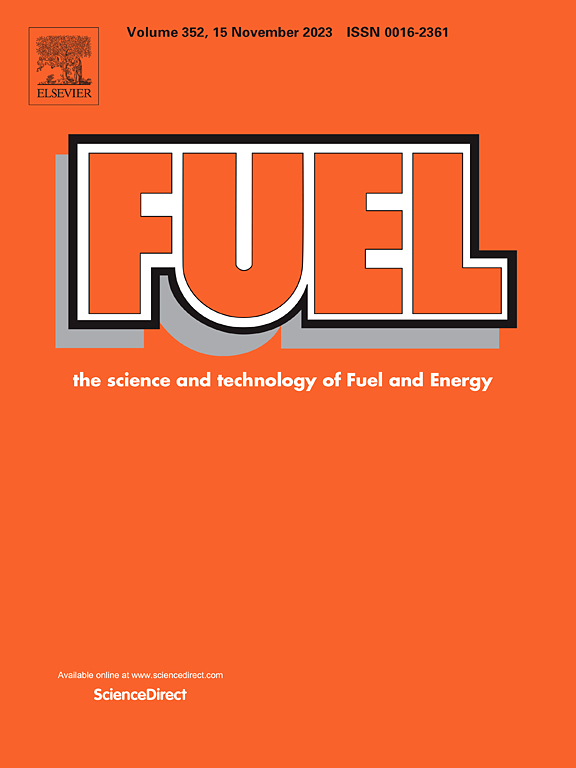Synthesis of carbon-zeolite bifunctional support Cu/C@Zeolite catalysts for enhanced VOCs catalytic oxidation
IF 6.7
1区 工程技术
Q2 ENERGY & FUELS
引用次数: 0
Abstract
In this study, the Cu/C@Zeolite catalysts with carbon-zeolite bifunctional support was developed by using the zeolite-induced one-pot homogeneous synthesis of CuBTC composite (CuBTC@Zeolite). Three different zeolites (ZSM-5, 13X, NaY) and the activation conditions were discussed. Originating from the defective structure of CuBTC in the composite and its interactivity with the zeolite, compared to Cu/C, the Cu/C@zeolite catalysts had the hierarchical pore system, a higher content of oxygen vacancies, stronger redox properties, and more active Cu sites with smaller particle sizes and more Cu+/Cu2+ coexisting valence states, in synergy with acid sites, all of these contributing to the improved catalytic activity for VOCs oxidation removal. The activity of toluene catalytic oxidation indicated by T90 was in the order of Cu/C@NaY (268.5 °C) > Cu/C@ZSM-5 (280.0 °C) > Cu/C@13X (287.0 °C) > Cu/C (320.0 °C). They also performed a better activity for acetone and ethyl acetate oxidation, obtaining the lowest T90 at 217.0 and 231.5 °C respectively when the Cu/C@NaY used. Moreover, the Cu/C@NaY and Cu/C@ZSM-5 performed good water resistance and stability, suggesting the potential in practical application scenarios. These findings underscored the potential of Cu/C@Zeolite catalysts for addressing complex VOCs in simultaneous catalytic oxidation.
本研究采用沸石诱导一锅均相合成 CuBTC 复合材料(CuBTC@沸石)的方法,开发了具有碳-沸石双功能载体的 Cu/C@Zeolite 催化剂。对三种不同的沸石(ZSM-5、13X、NaY)和活化条件进行了讨论。由于复合材料中 CuBTC 结构的缺陷及其与沸石的相互作用,与 Cu/C 相比,Cu/C@沸石催化剂具有层次分明的孔隙体系、更高的氧空位含量、更强的氧化还原特性、更多的活性 Cu 位点(粒径更小)以及更多的 Cu+/Cu2+ 共存价态,并与酸性位点协同作用,所有这些都有助于提高催化剂去除 VOCs 氧化的活性。T90 催化氧化甲苯的活性依次为 Cu/C@NaY(268.5 ℃)>;Cu/C@ZSM-5(280.0 ℃)>;Cu/C@13X(287.0 ℃)>;Cu/C(320.0 ℃)。它们在丙酮和乙酸乙酯氧化方面也表现出更好的活性,使用 Cu/C@NaY 时,在 217.0 和 231.5 °C 时分别获得了最低的 T90。此外,Cu/C@NaY 和 Cu/C@ZSM-5 还具有良好的耐水性和稳定性,这表明它们具有实际应用的潜力。这些发现凸显了 Cu/C@Zeolite 催化剂在同时催化氧化复杂挥发性有机化合物方面的潜力。
本文章由计算机程序翻译,如有差异,请以英文原文为准。
求助全文
约1分钟内获得全文
求助全文
来源期刊

Fuel
工程技术-工程:化工
CiteScore
12.80
自引率
20.30%
发文量
3506
审稿时长
64 days
期刊介绍:
The exploration of energy sources remains a critical matter of study. For the past nine decades, fuel has consistently held the forefront in primary research efforts within the field of energy science. This area of investigation encompasses a wide range of subjects, with a particular emphasis on emerging concerns like environmental factors and pollution.
 求助内容:
求助内容: 应助结果提醒方式:
应助结果提醒方式:


